About the Project
The materials here suggest that as academic work expands into video formats, it recasts behaviors based on print. The tensions in this proposition, in part, arise from the influence that print publication has had on our sense of scholarship. Consider the countless claims for digital disruption made in hardbound books. Print-oriented approaches provide powerful ways of capturing and sharing knowledge. They also shape what counts as understanding. If, as Gregory Ulmer suggests, "print favors and supports or augments an analytical mode of thought" (140), then moving beyond words will open up alternative possibilities.
Each chapter starts with a video made through screen composing. These videos include elements found in academic work. Activities like excerpting a source to provide a quotation appear as displays of texts, typing on screen, and voice narration. The videos also deploy movement, visuals, and sounds, pushing past some of the communicative possibilities of prose and print. These combinations challenge conceptions of reading and scholarship. The videos range along a continuum that starts with, on one end, recognizable academic forms and leads to, on the other, speculative modes linked with mixed media and screens. A video like Bridges Sing provides a narrative track, excerpts of texts, and reports on class activities that make the viewing experience reasonably familiar. A video like Waves, on the other hand, captures cutting and pasting blocks of text to make implicit points. Videos in varying amounts exhibit decipherability, scholarly gestures, affective sounds, visual layerings, and ambiguity—to name a few aspects. This continuum bridges familiar and alternative modes of scholarship and print and screen composing.
Chapters also include Discussion segments that connect the videos with scholarly and rhetorical concerns. The discussion is meant to further bridge print and digital composing by linking the videos with intellectual issues. These connections extend the alt-scholarship impulses of the project. The discussion aims not for closure, but for opening up meaning by adding conceptual layers that evoke resonances, initiate circuits, or provide pathways for more exploration.
Each chapter also includes Transcripts with background information and a prose translation of the video. The videos themselves include captions of audio and descriptions of visual elements. Together, the captions, descriptions, and transcripts improve access even as they raise questions. How can we augment the limited dialog and sounds typically found in captions? How should visual descriptions operate in combination with captions? How directly should descriptions seek to reproduce the experience of the videos? And how do transcripts extend and expand on video materials? The rich transcripts are key components of the project. As they rework spoken, written, sonic, and visual materials, they provide additional insights into video scholarship and a space for speculation on relationships between print and screen.
Information about materials and sources is also included in each chapter. The central components of the project are images, sounds, and texts gathered from the internet and from academic sources. In many cases, these are excerpted and integrated into the videos in typical scholarly fashion. In some cases, whole texts are copied, but not directly integrated into the composition—as in blog postings used to perform machine operations on texts. In other cases, significant portions of materials are used; however, their full presence never appears in the final piece, since windows are stacked, arranged, made transparent, or hidden on screen.
The purposes associated with the videos are similar to those behind scholarship in print. Images, sounds, and texts are integrated among one another to move forward conversations and explore intellectual concerns. The inclusion of entire blog postings in Waves conveys the message of printcentricity; a live musical performance in Trainsplaining prepares the ground for the affective, sonic arguments that will be delivered by speeding trains. Both videos deploy materials to offer commentary, teach concepts, and share scholarly response.
Screen composing also renders materials in ways that are nothing at all like their original sources. Any item brings a portion to the whole experience, since materials are layered together with browser and media windows, performances, citations, narration, and screen activities. The sources are transformed through mixing. The US Copyright Office describes "transformative uses [as] those that add something new, with a further purpose or different character, and do not substitute for the original use of the work." Because it extends the ways we compose, video scholarship transforms materials as it mixes artifacts to explore ideas.
Affirming, Speculating, Theorizing, and Teaching
The videos range from experiments in screen composing to audiovisual expositions of scholarly topics to reports on class activities. The arrangement of the chapters is not meant to imply a proper viewing sequence. If desired, you can sample chapters in any order. Spending time with several of the videos will reveal material resonances, common techniques, and thematic connections. The arrangements below suggest some of these connections and one possible way of grouping items.
Affirming
The project highlights aspects of academic communication. Scholarship, Rita Felski notes, is often "a mode of interpretation that adopts a distrustful attitude toward texts." This attitude translates into "distance rather than closeness; guardedness rather than openness; aggression rather than submission; superiority rather than reverence" (Suspicious Minds, 222). A number of concerns accompany these mind-sets. Foremost is the loss of compassion and empathy as scholars compete with one another for intellectual recognition. Many of the videos lay out these concerns, and then offer alternative, affirmative modes of response.
-

Blessing Critique (2016) Discusses the limits of critique and offers an alternative mode of "reading" a poem. In translating thought into imagery, composers move over sliding scales: abstract and concrete; emotion and logic; decipherability and ambiguity
-

Refiguring Citation (2016) Looks at citational, ethical, and compositional questions for video scholarship. Student reflections shed light on not only screen composing but also the disciplinary, cultural, and legal concerns associated with mixing media
-

Waves (2012) Responds to the claim that digital humanities creates meaning "produced not by anyone but by everyone in concert" (Fish). The video highlights the ways that print biases permeate scholarly defenses of this vision
Speculating
Familiar behaviors make it difficult to recognize new modes. Erin Manning and Brian Massumi warn that disciplines tend to reject "transversal modes of thought" in favor of "a static organization of preformed categories" (30). Given our networked and emergent contemporary theories of knowledge, the traditional channels seem an overly fixed mode for scholarship. Johanna Drucker and Bethany Noviskie suggest we "go beyond descriptive, generative, or predictive approaches to become speculative." Henri Bergson finds in speculation the importance of opening a problem "even more than of solving it" (36–37). The videos evoke these processes of uncovering.
-

Screenshots (2012) Brings together several windows simultaneously while flooding audio channels with multiple sources of sound. Traditional ways of framing scholarly understanding are replaced by choral modes with shifting boundaries
-
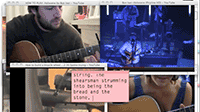
Truing (2012) Emphasizes the sonic aspects of video scholarship. Multiple song iterations are combined with how-to videos and live typing as the piece is performed, highlighting the "tuning" activities and materialities of screen composing
-
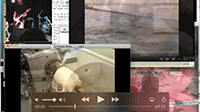
Sediment (2012) Reflects on conceptions of memory and time. Geologic processes are linked with "loops" through which time is recast into "durations." Videos from prior projects resurface, are repurposed, and then settle again as sediment
Theorizing
Through narration, the integration of citations, and sonic and visual materials, the project offers insights into familiar conceptual questions. Theories based on networks or systems are instantiated in the windows and activities of the screen, which have "a deep virtual reach to archives and databases" (Friedman, 19). Intertextuality, posthumanism, and emergence are captured in the composing. Bruno Latour tells us to "go with the flow . . . follow the circulating entities" (237). The videos experiment with this directive as they take up scholarly topics.
-

Bridges Sing (2017) Takes up the role of data in culture and scholarly research. Highlights the balance to be struck between database and narrative, actualizing these two impulses through dialog and evoking posthuman connections between people and machines
-

I'm a Map (2010) Drawing on the proposition that when creativity loses its novelty, it seeks out new channels, the video offers the Mac and PC characters of Apple's "Get a Mac" advertising campaign as models for metaphor in the realm of the screen
-
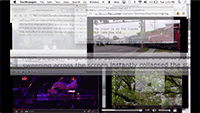
Trainsplaining (2014) Suggests that we process video scholarship and screen composing through emergent mixing of intellect and feelings. The piece deploys sonic and visual materials that offer an argument not about but through affect
Teaching
Screen composing reshapes activities in the classroom. And students are capable creators of video scholarship. These projects extend printcentric orientations of academic work. Ian Bogost notes that scholarly "obsession with writing creates numerous problems" (89) and asks, "Must scholarly productivity take written form?" Diane Davis tells us that typical assignments require students to "fix meaning and erect solutions" (252). Video scholarship features extralinguistic meaning, emergence, affect, and ambiguity—qualities traditionally edited out of student work. Many of the videos explore the implications of opening classroom activities to video scholarship and screen composing.
-
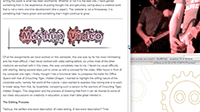
Watch the Bubble (2011) Blends memoir, manifesto, and media while reflecting on historical moments at the intersections of computers and composition. The piece suggests that composing against the grain of software can reveal the materiality of the screen
-

Casting Learning (2011) Reports on videos developed in an undergraduate literature class. The piece argues that audiovisual composing projects involve risk on the parts of students, and deliver corresponding payoffs in motivation and creativity
-
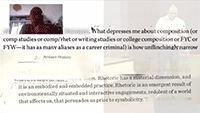
So Much Depends (2016) Offers a screen-based critical response to the poem "The Red Wheelbarrow." The response also explores approaches to teaching composition, highlighting academic fixation on the essay and calling for more imagination
I would like to thank the Sweetland Digital Rhetoric Collaborative for their support. Without their efforts, the project would not exist. For all pathways opened, thanks to Cheryl Ball, Doug Eyman, and all those associated with the journal Kairos and Kairos Camp. Deep thanks to the many students who have been trusting enough to explore the possibilities of screen composing and share their work. Special thanks to the colleagues who have offered feedback and guidance over the years: to Jason Loan for the numerous "video conversations" that pushed the speculative potential of the screen; to Adam Engel for sharing the joy of video poetry; to Ashley Hall and to Jennifer Ware for their ongoing collaboration and inspiration. Thanks to Carly Schnitzler and Sarah Walton for the insightful feedback and assistance with the project. Deepest thanks to Cindy, Peter, and Palmer Anderson for making it all meaningful. In memory of Roger Yates Anderson.

